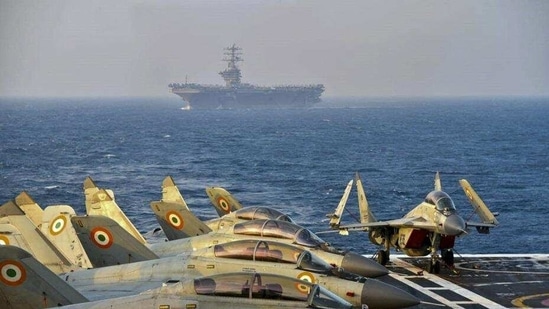
The four-nation Quad grouping may add a new layer of interactions at the level of top security officials to coordinate their posture and specific roles in the Indo-Pacific, a senior government official said on plans to scale up cooperation among its members.
Leaders of the United States, India, Japan and Australia held their first summit-level meeting earlier this month, signalling that the four countries would continue efforts to build their four-way alliance that is often seen as an emerging bulwark against China. The March 12 summit reviewed common challenges across the Indo-Pacific - especially China’s assertive actions - but didn’t get into the details of these threats since the meeting was being held online.
The challenges posed by China will be taken up by the four leaders when they hold their in-person meeting on the sidelines of the G-7 summit in the United Kingdom or at the invitation of US President Joe Biden later. An in-person meeting of the Quad foreign ministers is also expected this year.
People familiar with discussions among the four countries said there were suggestions for a Quad dialogue among their top security officials who could decide on the road map for cooperation in the Indo-Pacific. This could be the umbrella group at the official level to share information and decide on the response to common challenges.
So far, the four countries have mostly focused on quadrilateral dialogue led by their top diplomats and foreign ministers. News reports from Japan also indicate that the next step is going to be multi-layered cooperation among the Quad partners.
“It is inevitable,” a government official said. Already, the navies of Quad plus France are exercising under the “La Perouse” banner in the Bay of Bengal from April 4 to 7 with the Indian Navy sending an attack submarine and a destroyer for the war games.
Although some strategic experts underline that the Quad partners differ in their perception of threats from China and have different policies to deal with Beijing, the evolving Quad architecture is not only aimed at China and provides a democratic alternative to ASEAN, Gulf and African countries in the Indo-Pacific. Already, France and the UK have shown keen interest in the Indo-Pacific and have expressed interest in tying up with India and Australia.
The 2021 East Asia Review by the Japanese defence ministry’s strategic think tank, National Institute for Defense Studies, notes that all the four countries view the Quad grouping as a hedge to prepare for an uncertain future as US-China tensions rise and Beijing takes increasingly aggressive action in the South China Sea and the Korean peninsula.
With China tightening control over Hong Kong, eyeing Taiwan and threatening both Japan and the US over Senkaku Islands, India has decided to work closely with other countries at bilateral and multilateral levels as the next focus of China’s People’s Liberation Army Navy is the Indian Ocean where it is expected to deploy its warship deployments as early as 2023. Besides, India also has a land boundary dispute with China that Beijing does not appear inclined to settle and prefers to use it as a lever to unsettle and pressurise India.
Discussions on steps to ensure a free, open and inclusive Indo-Pacific region are also expected to top the agenda when the Defence Policy Group of the two countries meet next. “The decision is still to be taken but scheduling a DPG at the defence secretary official level is being considered,” said a senior government official about the bilateral mechanism that was revived in 2019 after a four-year gap.
For Reference Click Here
Comments
Post a Comment